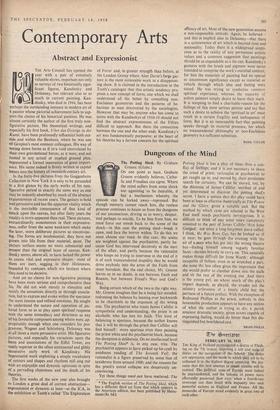Contemporary Arts
Abstract and Expressionist
THE Arts Council has opened the year with a pair of extremely valuable shows, important not only as surveys of two historically signi- ficant figures, Kandinsky and Delaunay, but relevant also to so >i1I .....0 dmiuncskhy,inwhColldrrieedntin pla9i n44t i n gi a. s Kb ea enn- perhaps the outstanding instance in modern art of a painter whose pictorial achievement fails to sup- port the claims of his historical position. He was almost certainly the author of the first truly non- figurative picture. His theoretical writings, and especially his first book, Uber das Geistige in der Kunst, have been profoundly influential both out- side and within the Bauhaus, where he was one of Gropius's most eminent colleagues. His way of setting down forms as if irr.a void interrelated by their own gravitational forces, as it were, and not tooted in any actual or implied ground plan, represented a formal innovation of great import- ance. His name indeed is firmly written in capital letters into the history of twentieth-century art.
In the forty-five pictures from the Guggenheim Collection in New York it is easy to be persuaded at a first glance by the early works of his non- figurative period in exactly the same way as one may be instantly absorbed by much of the abstract expressionism of recent years. The gesture is bold and persuasive and has the apparent vitality which is the inevitable consequence of that kind of attack upon the canvas, but after forty years the vitality is more apparent than real. These pictures, extraordinarily monotonous in their expressive- ness, suffer from the same weakness which make the later, more deliberate pictures so unconvinc- ing. The forms are insubstantial; they have not grown into life from their material, paint. The picture surface seems no more substantial and present than the original layer of canvas. Kan- dinsky seems, above all, to have lacked the power to create vital and expressive shapes: most of them are inert, sagging in their lifelessness, bounded by contours which are hesitant where
they need to be decisive. .
And yet no claims for non-figurative painting have been more serious and comprehensive than his. He did not wish merely to stimulate and satisfy the sensations directly or through associa- tion, but to express and evoke within the spectator the most intense and refined emotions. He sought to understand the nature and operation of pic- torial form so as to play upon spiritual response with the same immediacy and directness as any of his favourite composers among whom were ap- propriately enough when one considers his pro- gramme, Wagner and Schonberg. Delaunay was at all times a more persuasive artist. His figurative pictures, and especially his variations upon the form and associations of the Eiffel Tower, are vastly superior to the often sentimental' and glibly decorative early work of Kandinsky. His Supremacist work exploiting a simple vocabulary of colours and shapes and rhythms still sing out with an enjoyable and dynamic optimism in spite of a pervading clumsiness and the death of his theories.
The first weeks of the new year also brought to London a great deal of current abstraction— expressionist or dynamic at least—at the ICA, in the exhibition at Tooth's called 'The Exploration of Form' and, in greater strength than before, at the London Group where Alan Davie's large pic- ture is the most noticeable work in a disappoint- ing show. It is claimed in the introduction to the Tooth's catalogue that this artistic tendency pro- poses a new concept of form, one which we shall understand all the better by consulting non- Euclidean geometries and the patterns of be- haviour in man discovered by the sociologists. However that may be, anyone who has come to terms with the Kandinskys of 1910-19 should not find the abstract expressionism of the Fifties difficult to approach. But there the connection between the one and the other ends. Kandinsky's art was fundamentally purposive; at the heart of his theories lay a fervent concern for the spiritual efficacy of art. Most of the new generation assume a non-responsible attitude. Again, he believed— and this is implicit also in Delaunay—that there is a quintessence of art which is beyond time and nationality. Today there is a widespread scepti- cism as to the reality of any permanent artistic values and a common suggestion that paintings should be as expendable as a tin can. Kandinsky's gestures with the brush and pigment were never intended to comprise the work's essential content; for him the materials of painting had no special or uncommon significance except as material or vehicle through which idea and feeling were stated. He was trying to symbolise common spiritual experience, whereas the majority of action painters simply desire to leave their mark. It is tempting to find a charitable-reasOn for the failings of this most serious painter and say that such a desire to achieve the 'spiritual in art' must result in a certain fragility and ineloquence of form. But it is an inescapable fact that painting speaks through its material presence, for which no transcendental philosophy or non-Euclidean geometry is a sufficient substitute,
BASIL TAYLOR






























 Previous page
Previous page